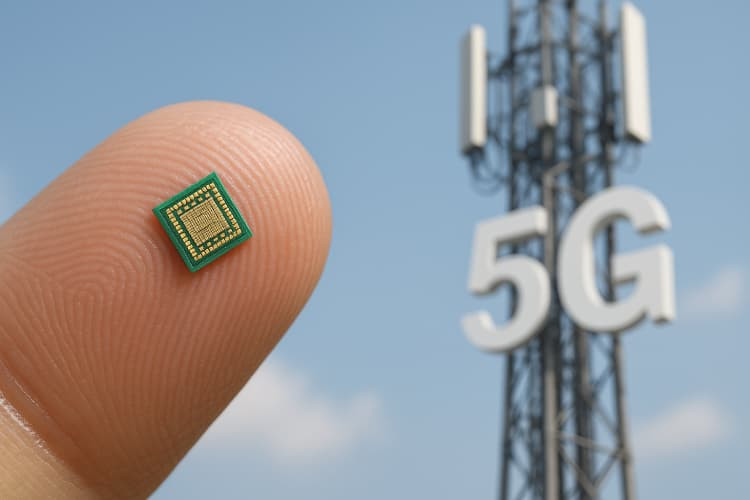5G Low-Power Chip Cuts Energy Use in IoT Devices
Insights | 30-07-2025 | By Robin Mitchell

Key Things to Know:
- 5G’s energy demands are straining both infrastructure and device-level power budgets, challenging the viability of long-life, always-on IoT deployments.
- MIT researchers have developed an ultra-low-power 5G receiver chip that operates under one milliwatt while rejecting interference in dense RF environments.
- The chip's innovative design uses switch-capacitor networks and bootstrap clocking to reduce power consumption without compromising performance or reliability.
- With a footprint smaller than a speck of dust, the prototype chip could enable batteryless IoT devices powered by ambient Wi-Fi or Bluetooth signals.
While 5G has been hailed as the next great leap in wireless communication, bringing faster speeds and ultra-low latency to a hyper-connected world, its rollout hasn’t come without drawbacks. One of the most critical yet under-discussed challenges is energy consumption—both at the device level and across network infrastructure. As billions of IoT devices depend on reliable, long-lasting power to stay online, 5G’s higher signalling complexity is pushing existing energy budgets to the brink.
What is causing 5G’s energy problem, why does it matter for the future of IoT and connected devices, and how might emerging technologies like MIT’s ultra-low-power receiver chip offer a solution?
The 5G Energy Problem
5G was marketed as the future of wireless communication, and in many ways, it is. We were promised lightning-fast speeds, ultra-low latency, and the ability to support a dense ecosystem of connected devices. That promise has partly been delivered, but not without some serious trade-offs. One of the most pressing issues is energy consumption.
The Power Cost of Always-On Connectivity
To be clear, 5G can offer excellent performance under ideal conditions. When you're standing near a well-placed small cell with good line-of-sight, the speeds are impressive. But outside of that sweet spot, coverage becomes inconsistent. Walls, trees, and even light rain can reduce signal strength, and switching between 4G and 5G mid-session is still a common frustration. In short, it's not the seamless, high-speed experience we were sold.
Beyond infrastructure and coverage challenges, there's another issue that gets less attention: energy efficiency, or lack thereof. As more IoT devices come online, from smart meters and wearables to security sensors and industrial monitors, they increasingly rely on 5G connectivity. These devices are often battery-powered and expected to last for years in the field. However, with 5 G's higher signalling complexity and increased handshake overhead, they burn through power much faster than with 4G or LPWAN alternatives.
Infrastructure Overhead and Sustainability Questions
This creates a real design challenge. Engineers are being asked to develop devices that are smaller, smarter, and connected 24/7, but the energy budget simply doesn't match up. Firmware optimisations and low-power chipsets help, but they can only go so far when the network itself demands more power.
It's not just the endpoints feeling the squeeze. 5G base stations consume significantly more power than 4G towers, and they need to be deployed far more densely. More radios, more antennas, more processing, and more electricity. This creates scalability issues and drives up operating costs, especially in regions where power is expensive or infrastructure is already under strain.
In a world supposedly pushing for sustainability, it's a bit ironic that our most advanced wireless standard might be the least energy-efficient.
None of this is to say 5G doesn't have value. It absolutely does. But the industry needs to temper its enthusiasm with realism. Not every application needs 5G. For low-data, long-life devices, protocols like LTE-M, NB-IoT, or even Wi-Fi are still the smarter choice. And when deploying 5G, engineers must consider both performance and power, not just for user experience, but for long-term viability.
MIT's Tiny Power-Sipping Chip Could Be a Game-Changer for 5G IoT
Recently, a team at MIT claimed to have cracked that code with a receiver chip that operates at less than one milliwatt while suppressing unwanted interference across 5G bands.
According to MIT, the chip’s enhanced filtering capability stems from a switch-capacitor network that mitigates harmonic interference at the earliest stage of the signal chain. This architecture allows for signal isolation before amplification, which is key to maintaining integrity in congested RF environments typical of urban 5G deployments.
Power Efficiency That Shifts Design Constraints
This is not just an incremental improvement; it's a 30x gain in power efficiency compared to conventional systems. And if you're designing smart sensors, wearables, or any always-on device, that number isn't just nice to have, it's make or break.
Such efficiency gains are particularly relevant in industrial IoT environments where uptime and reliability are prioritised. Devices used in predictive maintenance or environmental monitoring often run unattended for years, and any reduction in energy use directly correlates with deployment longevity.
Addressing Interference with Smarter Architecture
Most IoT devices today use narrowband filters to reject interference from nearby wireless signals. The problem? These filters consume power and take up space, both of which are at a premium in battery-powered systems. As 5G expands into wider bands and denser environments, filtering becomes even more critical. MIT's solution is both elegant and aggressive: a switch-capacitor network that blocks out unwanted signals without chewing through energy.
The chip’s design eliminates the need for bulky, off-chip filters by leveraging on-die components that deliver narrowband performance without occupying board space. This aligns with a broader industry trend toward miniaturised radio frequency front ends in mobile and edge computing devices.
Minimising Power Without Compromising Performance
The team first introduced the core architecture in 2023, showing how a smart capacitor array could share charge while isolating noise. The updated design adds bootstrap clocking, allowing the circuit to run reliably at just 0.6 volts, an exceptionally low operating point that helps keep overall power usage below a milliwatt.
A notable technical detail is the use of bootstrap clocking, a circuit-level innovation that allows the chip’s tiny switches to operate reliably at low voltages. MIT’s team reports that this method reduces the control overhead typically required by traditional clock-boosting systems, while maintaining signal fidelity.
In practical terms, this means devices like smart thermostats, indoor security cams, and even fitness wearables could be made significantly smaller by downsizing or outright removing the battery. Lower power also means less heat, longer lifespan, and less strain on the grid or charging systems.
The implications for sustainability are also noteworthy. Reducing the need for frequent charging cycles helps to lower the carbon footprint of connected devices, particularly in regions where grid access is limited or where device volumes scale into the millions.
Tiny Silicon, Big Future for Energy Harvesting
The total chip area? Just 0.05 square millimeters. That's smaller than a speck of dust, but what it enables could reshape product design for years to come. Lower leakage, better interference rejection, and efficient signal capture, all in a package small enough to fit into a health patch or environmental sensor node.
By compressing advanced receiver functionality into such a small silicon footprint, the team also opens the door to multi-chip system-on-package (SoP) integrations. This could accelerate the development of next-generation wearables and edge AI modules where board real estate is at a premium.
It's still a prototype, but the research group isn't stopping there. Their end goal is to eliminate batteries altogether, replacing them with energy-harvesting systems that draw power directly from ambient Wi-Fi and Bluetooth waves. That vision might sound ambitious, but it's technically feasible, especially for low-bandwidth, intermittently active devices.
The researchers are also exploring ambient RF energy harvesting as a potential long-term power source. In principle, the chip could be self-sustaining in environments rich with Wi-Fi or Bluetooth signals, making it well suited to smart infrastructure or medical patches where battery replacement is infeasible.
Could This New Chip Change 5G and the IoT Industry?
For engineers working on real-world IoT deployments, this chip is far more than a flashy lab demo. Power efficiency has always been the gating factor for battery-powered wireless devices. You can have all the bandwidth and processing power you want, but if your sensor dies after a few hours, it's a non-starter. This is especially true for systems that are deployed remotely or embedded in infrastructure where routine maintenance is either expensive or flat-out impossible.
MIT's new receiver architecture attacks this problem at the root. It doesn't just trim power use, it rewrites the equation. A receiver that operates under 1 milliwatt, with robust interference rejection and support for wideband 5G signals, represents a fundamental shift in what's possible. Instead of compromising performance to stretch battery life, engineers may soon design devices that meet modern connectivity standards and run for years, or even forever, without intervention.
This has direct implications across industries. Smart agriculture can deploy more dense, autonomous sensor networks in harsh environments. Smart cities can embed infrastructure monitoring into concrete, roads, and bridges with no need for wired power or battery replacements. Wearables and medical implants can shrink in size, increase in capability, and reduce the risk and cost of surgery or replacement. Even military and industrial monitoring applications, which often run in electromagnetic noise-heavy environments, stand to benefit from better filtering and reduced emissions.
More importantly, this chip opens the door to batteryless IoT. That's not a buzzword, the MIT team is actively exploring energy harvesting from ambient RF signals like Wi-Fi and Bluetooth. Combine that with sub-milliwatt power draw, and you're no longer just extending device lifetime, you're eliminating a major failure point altogether.
So yes, this chip could absolutely reshape the trajectory of the 5G and IoT industries, not through hype or marketing, but by addressing the unglamorous, often overlooked constraint that limits real-world adoption: power.
The takeaway? 5G isn't just about faster downloads or low latency. It's about enabling millions of connected devices to operate reliably and efficiently in the field. And breakthroughs like MIT's chip are what make that vision credible, and achievable.

